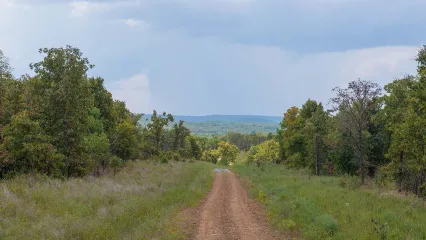
There's a spot on the Cherokee Wildlife Management Area where you can feel Oklahoma's pioneer history. It's an old homestead, long ago reclaimed by the surrounding rolling hills. Oak and hickory timber encroaches on the one-time settler's meadow that is surrounded by a hand-stacked rock fence.
It's impossible to say exactly what the old fence has witnessed over the decades but sometimes it's better to use your imagination when it comes to such matters. It is. however, impossible to escape the feeling of isolation that those early homesteaders must have felt. This country is rough, rugged, wild, and plenty hard on a guy who's only half in shape.
You can, this very day, even see a herd of elk grazing in the meadow much like what pioneers might have seen two hundred years ago.
And for me, that's what makes this place so special. We can't go back in time to stay, but we can go back just for a visit.
Nestled in some of northeast Oklahoma's most striking hardwood hills, the Cherokee Wildlife Management Area (WMA) is a true gem. Bounded by the Camp Gruber Military Training Center on the west and the hollows that drain into lake Tenkiller on the east, Cherokee WMA offers a little bit of everything for all outdoor enthusiasts.
The area is a mixture of uplands with scattered fields and small streams. Numerous ponds dot the landscape. Oak-hickory timber on rolling hills predominate while fields and meadows with native bunch grasses and brushy thickets can be found on the WMA. The main drainage is Greenleaf Creek, which runs east to west, and contains typical bottom land over-story such as sycamore, elm, ash, hackberry, mulberry and pecan. The average annual precipitation is about 41 inches.
A traditional destination for many deer hunters, both the public hunting area (PHA) portion and the game management area (GMA) portion of the WMA offer deer hunting opportunities. Generally speaking, hunting seasons on the PHA are similar to statewide season dates, while the GMA offers limited access for small game and archery deer hunting during select times of the year. Controlled deer hunts are also offered through the department's controlled hunt program.
Wild turkeys, while found in good numbers throughout the area, can be challenging to pursue as hunting pressure is often high at this popular destination. The WMA also hosts many houndsmen each year. as creek bottoms and oak ridges lend themselves to pursuing raccoons and striking up friendly wagers on whose dog will strike first.
Of primary interest to those who enjoy viewing wildlife, a resident herd of some 30-50 elk can be found in the grassy meadows of the GMA portion. Eagles occasionally winter along Greenleaf Creek although viewing is limited.
One designated primitive camping area is found in the PHA Lodging is found in Tahlequah and Muskogee. The Tahlequah Chamber of Commerce can be reached at (918) 456-3742 and the Muskogee Chamber of Commerce can be reached at (918) 682-2401.
A rifle range which is closed during deer seasons can be found on the north end of the PHA. It offers both 50- and 100-yard ranges, with covered shooting benches on the 100-yard range.
Description of Fish and Wildlife Management Practices
Management efforts focus on improving the forage base for game species by controlled burning. mowing, strip discing, timber management, and establishing agricultural food plots Annually 200-300 acres (100-150 food plots) are planted on the area. Ponds are scattered throughout for wildlife watering. Those holding water year-round are stocked with bass. sunfish and catfish.
Fishing Opportunities
Fishing is limited to those area ponds that hold water year-round and Greenleaf Creek. Light tackle is generally appropriate. Abundant fishing opportunities can be found for a variety of species on nearby Webbers Falls. Greenleaf and Tenkiller lakes.
Vital Statistics
- 31,360 total acres
- Area is divided into 16,000-arce Public Hunting Area (PHA) and a 15,360-acre Game Management Area (GMA)
- Located two miles south of HWY. 62 at Zeb, OK
- Biologist, Brent Morgan also manages the Tenkiller wildlife management area. Contact number is (918) 931-0432 and his email address is brent.morgan@odwc.ok.gov